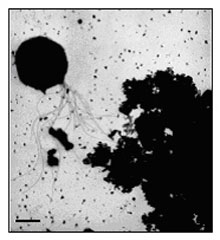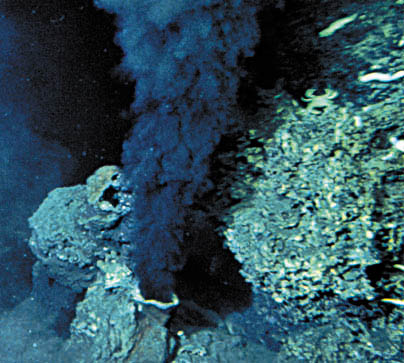Geogemma barossii: Difference between revisions
No edit summary |
|||
| Line 12: | Line 12: | ||
==Description and Significance==<br>[[image:microbes_right_220.jpg]]<br> | ==Description and Significance==<br>[[image:microbes_right_220.jpg]]<br> | ||
<b>Appearance</b>: <i>G. barossii</i> is a coccoid Archaea, about 1.0 micrometers in diameter, with lophotrichous-like flagellation.<br> | <b>Appearance</b>: <i>G. barossii</i> is a coccoid Archaea, about 1.0 micrometers in diameter, with lophotrichous-like flagellation.<br> | ||
<b>Habitat</b>: This hyperthermophile was originally discovered living in a deep sea hydrothermal called Finn, located in the Mothra hydrothermal vent field along the Endeavor segment of the Juan de Fuca Ridge, in the Northeast Pacific Ocean, roughly 200 miles off Puget Sound. This “black smoker” vent is roughly a mile and a half deep. The microbe was found in a sulfur and iron-rich environment with a temperature range of 85-121 degrees Celsius. <i>G. barossii</i> can survive at 130 degrees Celsius, but remains bacteriostatic.<br> | <b>Habitat</b>: This hyperthermophile was originally discovered living in a deep sea hydrothermal vent called Finn, located in the Mothra hydrothermal vent field along the Endeavor segment of the Juan de Fuca Ridge, in the Northeast Pacific Ocean, roughly 200 miles off Puget Sound. This “black smoker” vent is roughly a mile and a half deep. The microbe was found in a sulfur and iron-rich environment with a temperature range of 85-121 degrees Celsius. <i>G. barossii</i> can survive at 130 degrees Celsius, but remains bacteriostatic.<br> | ||
<b>Importance</b>: It was previously believed that no organism could live beyond 121 degrees Celsius. In fact, the highest temperature believed to be tolerable was 113 degrees Celsius which P. fumarii is capable of tolerating. The ability to grow at such extreme temperatures increases the variety of environments microbes could be found in. This could hint to when and where Archaea may have lived on primordial Earth as well as how far deep into the Earth microbes could live today. This discovery also leads to the potential for life in harsh extraterrestrial environments. | <b>Importance</b>: It was previously believed that no organism could live beyond 121 degrees Celsius. In fact, the highest temperature believed to be tolerable was 113 degrees Celsius which P. fumarii is capable of tolerating. The ability to grow at such extreme temperatures increases the variety of environments microbes could be found in. This could hint to when and where Archaea may have lived on primordial Earth as well as how far deep into the Earth microbes could live today. This discovery also leads to the potential for life in harsh extraterrestrial environments. | ||
Revision as of 04:33, 20 September 2011
Classification
Domain: Archaea
Phylum: Crenarchaeota
Class: Thermoprotei
Order: Desulfurococcales
Family: Pyrodictiaceae
Genus: Geogemma
Species: G. barossii
==Description and Significance==
Appearance: G. barossii is a coccoid Archaea, about 1.0 micrometers in diameter, with lophotrichous-like flagellation.
Habitat: This hyperthermophile was originally discovered living in a deep sea hydrothermal vent called Finn, located in the Mothra hydrothermal vent field along the Endeavor segment of the Juan de Fuca Ridge, in the Northeast Pacific Ocean, roughly 200 miles off Puget Sound. This “black smoker” vent is roughly a mile and a half deep. The microbe was found in a sulfur and iron-rich environment with a temperature range of 85-121 degrees Celsius. G. barossii can survive at 130 degrees Celsius, but remains bacteriostatic.
Importance: It was previously believed that no organism could live beyond 121 degrees Celsius. In fact, the highest temperature believed to be tolerable was 113 degrees Celsius which P. fumarii is capable of tolerating. The ability to grow at such extreme temperatures increases the variety of environments microbes could be found in. This could hint to when and where Archaea may have lived on primordial Earth as well as how far deep into the Earth microbes could live today. This discovery also leads to the potential for life in harsh extraterrestrial environments.
Genome Structure
As a member of Archaea, G. barossii has a single circular chromosome. As of April 21, 2009, Dr. Kashefi and Dr. Lovely have not published any information regarding the size of the genome. However, after a 16S rDNA analysis of 1100 base pairs, it is clear that the microbe is most closely related to Pyrodictium occultum (96.0% similar) and Pyrobaculum aerophilum (95.3% similar). Not much else is known about the genome of G. barossii at this time.
Cell Structure, Metabolism and Life Cycle
Cell Structure: Strain 121 does not show any exciting differences in structure compared to other Archaea. The cell envelope consists of a cytoplasmic membrane, a periplasmic space, and a single outer surface layer. This is all typical of Archaea.
Metabolism and Life Cycle: This organism is a very interesting obligate lithoautotroph. First of all, it uses iron like we use oxygen as a means of generating energy. It uses H2 as an electron donor and Fe(III) as an electron acceptor. It reduces Fe(III) to Fe(II) with magnetite as a by product. It grows fastest at 103 degrees Celsius with a generation time of about one hour. At 121 degrees Celsius the organisms had a generation time of 24 hours.
Ecology and Pathogenesis
Habitat: (See above)
Symbiosis: No symbiosis seen between other organisms. (It is the only organism that can grow at the high temperatures.)
Biogeochemical Significance and Environmental Contributions: Due to its unique iron-motivated respiration, the areas surrounding the vents where these microbes thrive are rich in Fe(II) and surprisingly, the magnetic mineral, magnetite. Magnetite is released as a byproduct of the ferric iron reduction to ferrous iron.
Pathogenesis: G. barossii poses no threat to humans. Due to its extreme living requirements, humans are unlikely to encounter this microbe anywhere outside of a lab. Even if exposure occurrs, the environmental temperatures would render the microbe dead.
References
Kashefi, Kazem. "Extending the Upper Limit for Life". 15 August 2003. Vol 301 Science.
Blochl, Elisabeth. P. fumarii, gen. and sp. nov., represents a novel group of Archaea, extending the upper limit of life to 131 degrees C.
L., Margarita. "Recent developments in the thermophilic microbiology of deep-sea hydrothermal vents". Extremophiles. 2006 10:85-96.
http://www.nsf.gov/od/lpa/news/03/pr0384_feature.htm
http://www.assatashakur.org/forum/afrikan-wholistic-health/5531-microbiology-strain-121-life-above-boiling-point.html
http://www.springerlink.com/content/y823745g8q646288/
Author
Page authored by Ying Liu and Andrew Leslie, students of Prof. Jay Lennon at Michigan State University.
